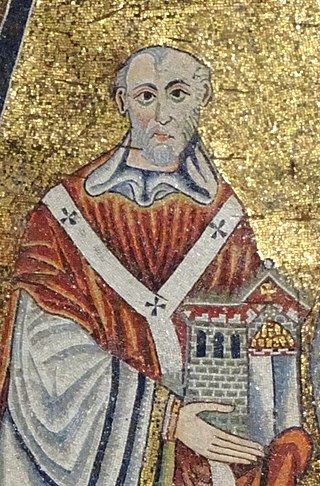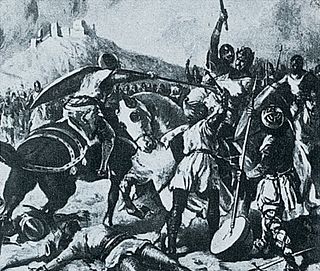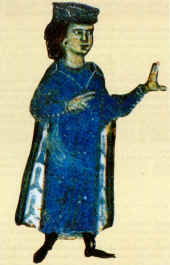Related Research Articles

Pope Innocent II, born Gregorio Papareschi, was head of the Catholic Church and ruler of the Papal States from 14 February 1130 to his death in 1143. His election as Pope was controversial, and the first eight years of his reign were marked by a struggle for recognition against the supporters of Anacletus II. He reached an understanding with King Lothair III of Germany, who supported him against Anacletus, and whom he crowned as Holy Roman Emperor. Innocent went on to preside over the Second Council of the Lateran.
Year 1141 (MCXLI) was a common year starting on Wednesday of the Julian calendar.
Year 1252 (MCCLII) was a leap year starting on Monday of the Julian calendar.
The 1290s was a decade of the Julian Calendar which began on January 1, 1290, and ended on December 31, 1299.
Year 1296 (MCCXCVI) was a leap year starting on Sunday of the Julian calendar.
Year 1293 (MCCXCIII) was a common year starting on Thursday of the Julian calendar.

Year 1213 (MCCXIII) was a common year starting on Tuesday of the Julian calendar.

The Holy Lance, also known as the Spear of Longinus, the Spear of Destiny, or the Holy Spear, is alleged to be the lance that pierced the side of Jesus as he hung on the cross during his crucifixion. As with other instruments of the Passion, the lance is only briefly mentioned in the Christian Bible, but later became the subject of extrabiblical traditions (Apocrypha) in the medieval church. Relics purported to be the lance began to appear as early as the 6th century, originally in Jerusalem. By the Late Middle Ages, relics identified as the spearhead of the Holy Lance had been described throughout Europe. Several of these artifacts are still preserved to this day.

William IX, called the Troubadour, was the Duke of Aquitaine and Gascony and Count of Poitou between 1086 and his death. He was also one of the leaders of the Crusade of 1101. Though his political and military achievements have a certain historical importance, he is best known as the earliest troubadour—a vernacular lyric poet in the Occitan language—by whom some work survives.

Isabella, also Isabel or Zabel, was queen regnant of Armenian Cilicia from 1219 until her death in 1252.

Marino SanutoTorsello was a Venetian statesman and geographer. He is best known for his lifelong attempts to revive the crusading spirit and movement; with this objective he wrote his Liber Secretorum Fidelium Crucis.
Alberic of Ostia (1080–1148) was a Benedictine monk, diplomat and Cardinal Bishop of Ostia from 1138 to 1148. He was one of the most important people in the administration of Pope Eugenius III, especially due to his diplomatic skills.

Samite was a luxurious and heavy silk fabric worn in the Middle Ages, of a twill-type weave, often including gold or silver thread. The word was derived from Old French samit, from medieval Latin samitum, examitum deriving from the Byzantine Greek ἑξάμιτον hexamiton "six threads", usually interpreted as indicating the use of six yarns in the warp. Samite is still used in ecclesiastical robes, vestments, ornamental fabrics, and interior decoration.
Grigor III Pahlavuni (1093–1166) was the Catholicos of the Armenian Apostolic Church from 1113 to 1166.

Reuven Amitai, also Reuven Amitai-Preiss, is an Israeli-American historian and writer, specializing in pre-modern Islamic civilization, especially Syria and Palestine during the time of the Mamluk Empire. In his 20s he moved to Israel, and became history professor at the Hebrew University of Jerusalem. As of 2012 he is the Dean of the Faculty of Humanities at the Hebrew University.
Thaddeus was an Armenian bishop and friar. He was consecrated as the Armenian Apostolic bishop of Caffa by the Caucasian Albanian catholicos Stepanos IV in or before 1321. The papal bull Doctor gentium egregius of Pope John XXII, dated 22 November 1321, refers to him as "the son of perdition ... who separated from unity with the church." He opposed the sitting Latin bishop, Jerome of Catalonia. In 1322, however, he converted to Roman Catholicism and joined the Dominican Order. He may have been promised in exchange the right to succeed Jerome when the latter died. The question of the chronology of the Catholic bishops of Caffa in this period is somewhat confused.
This list of works on the history of the Crusades and their mainly Muslim opponents, provides a select bibliography of modern works that are frequently cited in books, papers and articles that discuss these "holy wars". Thousands of histories on these topics have been published between the 11th and 21st centuries; this page only lists modern works on the topic. Works included are referenced in the notes or bibliographies of scholarly secondary sources or journals. Included works are: published by an independent academic or notable non-governmental publisher; authored by an independent and notable subject matter expert; or have significant independent scholarly journal reviews.
References
- ↑ James D. Ryan, "Toleration Denied: Armenia Between East and West in the Era of the Crusades", in Michael Gervers and James M. Powell, eds., Tolerance and Intolerance: Social Conflict in the Age of the Crusades (Syracuse, NY: Syracuse University Press, 2001), p. 63 and nn.
- ↑ P. N. R. Zutshi, "Collective Indulgences from Rome and Avignon in English Collections", in Michael J. Franklin and Christopher Harper-Bill, eds., Medieval Ecclesiastical Studies: In Honour of Dorothy M. Owen, Studies in the History of Medieval Religion, 7 (Woodbridge: The Boydell Press, 1995), p. 291.
- ↑ Jean Richard, La papauté et les mission d'Orient au Moyen Âge (XIIIe-XVe siècles), Collection de l'École Française de Rome, 33 (Rome: École Française de Rome, 1977), p. 220.